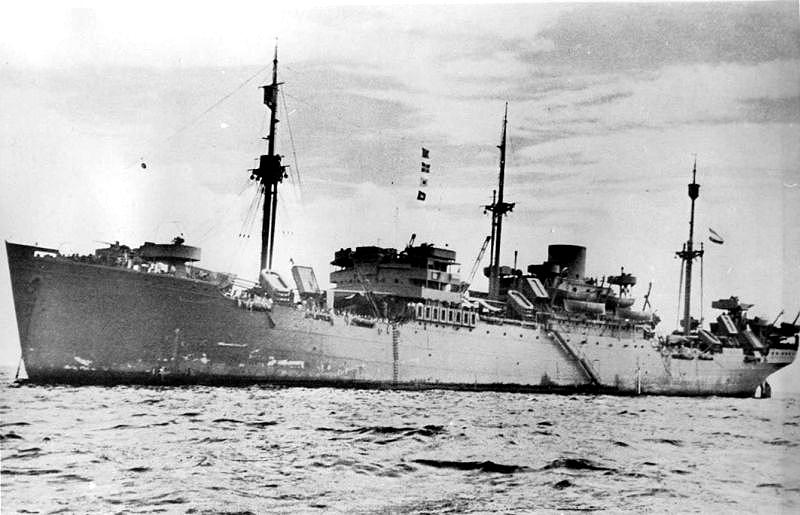
MS Tabinta 19 August 1930 to 1 December 1960 PHWE.
Construction order: 04-04-1929 NV Nederlandsche Scheepsbouw Maatschappij, Amsterdam.
Building Number: 202.
Invitation: f.3.932.371, -
Dimensions: 465.0 '(141.71) x 62.0' (18.90) x 36.3 '(11.05).
Measurement: 8.156 (b); 4898 (n0; 10336 (D); 510.545cft (bs); 602.840cft (gs); 3:34 (DT).
Machines: Werkspoor-Sulzer, Amsterdam 2tew8 cylinder diesel engine..
Verm./Snelh .: 7,040 epk; 1 screw, 15kb
Bunkers: 1.507 DO / 26
Type: Cargo ship with passenger accommodation, HDK, 2 x TDK, 3rd TDK in I and VI (front deck), 6 hatchbacks.
Accommodation: 21 passengers, 1.050 (M), 53/68 ), accommodation for pilgrims. In 1946: 17 passengers, 60? (B).
Equipment: 6EK (3)
Kiellegging: May 1, 1929.
Tewaterlating: 21 March 1930.
Delivery: 19 August 1930.
Would first be called MS Tambelan. Eventually it was named after Tabinta or Tobintha
on the West Coast of Celebes in the Indian Archipelago.The ship was a design of Ir HNPrins.
In 1933 equipped with more depth tank capacity. On December 21, 1934, MS Tabinta
entered the port of La Caruna with a burning charge where the fire was dumped by submerging
it underground. The ship arrived in Amsterdam on December 27th. In May 1940 on the Java
New York Line deployed for transportation for the British war industry. In 1941 a 4-inch
cannon was installed. On 1 October 1942, a refurbishment was completed to freight and
troop transport (approximately 2,200 man / cargo 291,500 cft) for the UA WSA. First
trip from San Francisco to Brisbane, Townsville and Cairns. Wracked up 325,000 nautical
miles in the Pacific in the war years. Released in San Francisco on January 9, 1946 and
in February 1946 to Indonesia. First arrival in The Netherlands on 14 April 1946 with
repatriates
. After that, chartered the Dutch Government for 3 years as a freight carrier.
Centralized back in the middle of 1950. In December 1960, sold to Hong Kong to Fourseas
Enterprising Co. to be demolished there in May.
The fifteen Dutch troop transport vessels in US service came from five different shipping companies:
Holland America Line (HAL):
ms Noordam
ms Sloterdijk
ms Sommelsdijk
Java China Japan Line:
Ms Tjisadane
Rotterdamsche Lloyd:
ms Brastagi
ms Japara
ms Kota Agoeng
ms Kota Baroe
ms Kota Inten
ms Weltevreden
Steamvaart Maatschappij Nederland (SMN):
ms Poelau Laut
ms Tabinta
United Dutch Shipping Society (VNSM):
ms Bloemfontein
ms Boschfontein
ms Klipfontein
|
----------------------------------------------------------------------------------------
At the end of 1941, the Tabinta of the SMN (Steamvaart Maatschappij Nederland) was
transformed in San Francisco into a troop transport ship.
The Allies made use of 202 troop transport ships during World War II.
In most cases, these were customized passenger ships or passenger ships.
The conversion of a passenger ship into a troop ship consisted of removing unnecessary luxury items such as
furniture, ornaments and decorations, and rescue lifeboats, wooden cages and hammocks aboard, so that the
transport capacity of soldiers became as much as possible. Furthermore, armament was placed on board in the
form of single guns and anti-aircraft guns. The bridges, steering houses, compass and map rooms were reinforced
with steel plates and concrete. Finally, the ships were painted in navy gray, black or camouflage colors.
The ships ranged from the Royal Mail Ship (RMS) Queen Elizabeth of the Cunard Line from 83,673 tons to 1,188 tons
of Perak from the Straits Steamship Company. A heavy toll occured with these troop transport ships and no less
than 56 were lost by war trades. The size of the sinked troop transport vessels ranged from the 42.348-tonne RMS
Empress of Britain of the Canadian Pacific Steamship Company, the largest sinked ship during World War II, to the
1,961-tonne Lafonia of Elder Dempster Ltd.
The Dutch troop transport vessels in US service were chartered by the US War Shipping Administration (WSA).
This service was established on February 7, 1942 under the umbrella of the War Powers Act 1941, the first US war laws.
The WSA was authorized to operate all ocean-going ships, except marine and other military vessels,
under US flag. Furthermore, the WSA ships could purchase, charter, rent and seize. In order to meet the demand for
sufficient troop transport ships, the WSA had to call on foreign shipping companies because there could not be enough
American passenger ships to be converted.
The WSA chartered fifteen Dutch passenger and passenger freighter ships converted to American yards at the end of
1941 or early 1942. Unlike Dutch troop transport ships in British service, no Dutch troop transport ship in American
service lost during the war. This was mainly because Dutch ships were deployed in US service in the Pacific, where,
unlike the Atlantic Ocean, there was almost no submarine threat. The Japanese had this offensive weapon less
developed than the Germans, and in addition, Japanese submarines were not used often against merchant ships.
At the end of 1945 and early 1946 the fifteen Dutch ships were released again.

